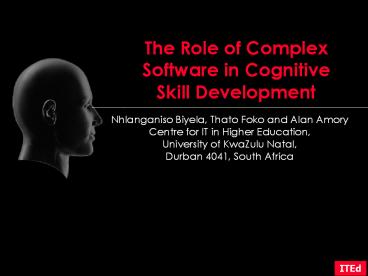The Role of Complex Software in Cognitive Skill Development PowerPoint PPT Presentation
Title: The Role of Complex Software in Cognitive Skill Development
1
The Role of Complex Software in Cognitive Skill
Development
- Nhlanganiso Biyela, Thato Foko and Alan Amory
- Centre for IT in Higher Education,
- University of KwaZulu Natal,
- Durban 4041, South Africa
2
Play
- Influences psychological, sociological, and
intellectual developments (Vygotsky, 1933/1978
Rieber, 1996) - Is an universally accepted mode of learning
(Blanchard Cheska, 1985) - Intrinsically stimulate curiosity through
(Thomas and Macredie, 1994) - Challenges and fantasy (Malone 1980, 1981a,b)
- Novelty and complexity (Carroll, 1982 Malone,
1984 Malone Lepper, 1987 Rivers, 1990)
3
Play
- Influences learning through visualization,
experimentation, and creativity (Betz, 1995) - Supports development of critical thinking though
- Discovery and problem-solving (Rieber, 1995)
- Object manipulation (Leutner, 1993)
- Goal formation and competition (Neal, 1990)
4
Game Object Model
The Game Space object includes four motivational
abstract interfaces play, exploration,
challenges, and engagement (Roberts, 1976 Malone
1980, 1981a,b Blanchard Cheska, 1985 Thomas
Macredie, 1994 Rieber, 1996).
5
Game Object Model
The Visualisation Space includes those interfaces
related to cognitive activities such as critical
thinking, discovery, goal formation, goal
completion, competition, and practice (Rieber,
1995 Neal, 1990 Amory et al., 1999), and
includes the concrete Story Line interface.
6
Game Object Model
The Elements Space object includes the abstract
interfaces of fun, and drama (Malone, 1981a,b)
and concrete interfaces of graphics, sound, and
technology (Amory et al., 1999) and actor
interaction, and gesture (Stanislavski, 1981
Harrigan, 1999). The drama, interaction, and
gesture interfaces are part of the Actor Space
object.
7
Game Object Model
The Problem Space object includes manipulation,
memory, logic, mathematics, and reflexes concrete
interfaces (Betz, 1995 Amory et al., 1999) that
support critical thinking, discovery, goal
formation and completion, competition, and
practice interfaces (Leutner, 1993 Quinn, 1994
Saljo, 1979 Schank Cleary, 1995) of the
Visualisation Space object.
8
Educational Software Design
- Software engineering methodologies
- None no product may emerge
- Rigid wrong product developed
- Newman and Lamming (1995) feedback system
- Situation of Concern document describes the
current unsatisfactory state of the world that
the software will attempt to solve Why. - Problem statement document
- Users who will exploit the system the Who,
- Human activity that the system will support to
satisfy the situation of concern the What, - Support provided by the system the How,
- Technology used to develop the system the With.
- The Who and What used to defined a persona
(characteristics of a fictitious user of the
system).
9
Educational Software Design
- But persona data
- not built from real information (either
quantitative or qualitative) - cannot be subjected to vigorous evaluations
10
Personal Outlining Model
GOM
Game Space
Visualization Space
Elements Space
Actors Space
11
Method
- Instrument
- Literacy (visual and logicalmathematical) skills
- Communication (reading and writing) skills
- Groups
- Senior school children
- No exposure to digital video games (n55)
- Played ?Khozi for more than 20h (n51)
- Humanities undergraduates (n30)
- Science undergraduates (n30)
- Geography undergraduates
- No exposure to GIS (n20)
- Used GIS for 1 semester (n20)
12
Results - Reading
1. School 2. School game 3. Humanities 4.
Science 5. Geography 6. Geography GIS
13
Results - Writing
1. School 2. School game 3. Humanities 4.
Science 5. Geography 6. Geography GIS
14
Results - 2D Visualization
1. School 2. School game 3. Humanities 4.
Science 5. Geography 6. Geography GIS
15
Results - 3D Visualization
1. School 2. School game 3. Humanities 4.
Science 5. Geography 6. Geography GIS
16
Results - 2D-3D Visualization
1. School 2. School game 3. Humanities 4.
Science 5. Geography 6. Geography GIS
17
Results Logical Mathematical
1. School 2. School game 3. Humanities 4.
Science 5. Geography 6. Geography GIS
18
Conclusions
- School children playing ?Khozi outperformed those
that had no exposure to this educational game - Science undergraduates performed better than
those from the humanities - Humanities students exposed to GIS performed best
- University undergraduate participants performed
better than the groups of senior school children - Participants working in teams were able to solve
complex problems with greater ease that those who
worked alone - Active viewers/participants and make their own
meaning

